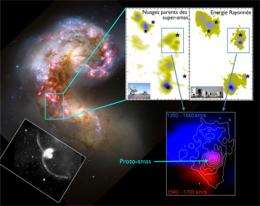The turbulent birth of super star clusters in galaxy mergers

By combining two of the most advanced telescopes in the world -- the new Atacama Large Millimeter Array (ALMA) and the Very Large Telescope (VLT) of ESO -- a team of French astronomers from the Institut d'astrophysique spatiale (IAS- CNRS) led by graduate student Cinthya Herrera has for the first time traced the very first steps in the formation of young super-star clusters in a nearby galaxy merger, the ÔÇťAntennaeÔÇŁ. This analysis, now published as an Astronomy & Astrophysics letter, not only represents a novel avenue for studying the very early stages of star formation in external galaxies, it is also ALMA's first scientific result ever to be published. It gives a foretaste of how ALMA will revolutionize our views on star formation and galaxy growth.
Mergers of massive, gas-rich galaxies are veritable fireworks of star formation, and many of the stars in galaxies formed during such short, vigorous events, from the early history of the Universe until today.
Such outbursts of star formation, starbursts, trigger the formation of giant clusters of millions of young stars within a few tens of light years. Similar volumes around our own solar system only contain a handful of stars.
Astronomers discovered the first super star clusters in the Antennae galaxy merger in images taken with the Hubble Space Telescope nearly 20 years ago, but until now, the physical processes which led to their formation were largely unknown. By combining the first ALMA data of the Antennae with observations previously obtained at the ESO VLT, the scientists are now able to trace directly how the galaxy merger triggers the formation of super star clusters. This study forms the backbone of Ms. Herrera's thesis work at the IAS in Orsay. A Chilean graduate student, she is doing her PhD thesis in France as part of a bilateral program between the CNRS and CONICYT (Chile). Understanding the astrophysical processes that lead to star formation and galaxy growth is one of the overriding scientific goals of ALMA.
Rather than studying young star clusters after they form, as has been done previously, Ms. Herrera followed a new approach by quantifying the energy lost by the gas in the star-forming clouds of the Antennae. Stars form from gas that is dense and very cold, however, in the Antennae, the galaxy merger stirs up the gas, making it highly turblent. To form new stars, the gas must lose this turbulent energy, so that it can cool, condense, and eventually collapse into a new star cluster.
This immense energy loss, predicted by theory, is now visible by using ALMA and the VLT. As the gas settles into gas clouds, and cools down, it emits a faint glow of light which can be observed with the VLT in the near-infrared. However, seeing this glow alone was not enough. The scientists also had to measure the turbulence in the surrounding gas clouds created by the galaxy merger, which is now possible with ALMA.
In only one of these clouds, the researchers found a clump of gas, massive enough to form a new super star cluster itself, which is radiating its turbulent energy very rapidly. In this region, where the gravitational pull of the galaxy merger is as its strongest, ALMA only sees an ordinary cloud, which for the VLT is the brightest object in all of the Antennae galaxies. In only a few million years, the blink of an eye in a galaxy's lifetime, this cloud will have lost all its turbulence, and a new cluster will be born. This first example illustrates the plethora of exciting new discoveries that astronomers like Ms. Herrera are hoping to make once ALMA reaches its full capabilities.
More information: ALMA CO and VLT/SINFONI H2 observations of the Antennae overlap region: mass and energy dissipation. Herrera, C. N., et al. 2012, A&A, volume 538, L9.
Provided by CNRS




















